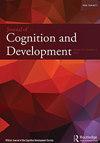阅读作为神经认知发展的文化工具:澳大利亚原住民和非原住民阅读习得与视觉空间发展之间的复杂互动关系
IF 2.1
2区 心理学
Q3 PSYCHOLOGY, DEVELOPMENTAL
引用次数: 1
摘要
摘要澳大利亚标准阅读评估测试被批评为在文化上不适合与澳大利亚土著儿童一起使用,特别是对于那些生活在偏远和非常偏远地区的儿童,因为这些测试在文化上偏向于澳大利亚主流文化,对土著知识、语言、概念和背景一无所知。基于对阅读习得与视觉感知发展之间关系的既定理解,我们试图检验土著和非土著儿童的视觉空间处理能力,以确定测量背侧和腹侧处理(与阅读相关的两个关键视觉过程)的视觉空间任务是否可以独立于阅读能力,提供跨文化阅读能力的指示性测量。使用连贯运动任务来测试背侧加工,我们发现年龄匹配的土著和非土著儿童的背侧加工发展相似(研究1),并且似乎有助于两个文化群体的早期阅读习得,与年龄无关(研究2和随后的分析)。总之,这些结果表明,虽然背突可能有助于阅读,但阅读并不是促进背侧发育的必要条件。此外,使用连贯的形式任务来测试腹面加工,我们发现腹面发育和阅读习得之间存在互动关系,尤其是对于非土著儿童。在解释这些发现时,我们讨论了可能解释土著和非土著儿童背侧和腹侧过程发展的文化因素,以及为什么土著儿童的腹侧过程和阅读习得之间的关系不明显。我们还考虑了基于神经认知优势为土著儿童提供支架式识字学习的潜力。本文章由计算机程序翻译,如有差异,请以英文原文为准。
Reading as A Cultural Tool for Neurocognitive Development: A Complex Interactive Relationship between Reading Acquisition and Visuospatial Development for Indigenous and non-Indigenous Australians
ABSTRACT Standard Australian reading assessment tests are criticized for being culturally inappropriate for use with Australian Indigenous children, particularly for those living in remote and very remote regions, as these tests are culturally biased towards mainstream Australian culture and imperceptive to Indigenous knowledge, language, concepts, and contexts. Based on an established understanding of the relationship between reading acquisition and visual perceptual development, we sought to examine the visuospatial processing ability of Indigenous and non-Indigenous children to determine whether visuospatial tasks that measure dorsal and ventral processing – two key visual processes associated with reading – can provide an indicative measure of reading aptitude across cultures, independent of reading ability. Using a coherent motion task to test dorsal processing we found that dorsal processes develop similarly for age-matched Indigenous and non-Indigenous children (Study 1) and appear to facilitate early reading acquisition for both cultural groups, independent of age (Study 2 and subsequent analyses). Together, these results suggest that while dorsal processes may facilitate reading, reading is not necessary to facilitate dorsal development. Additionally, using a coherent form task to test ventral processing, we found an interactive association between ventral development and reading acquisition, particularly for non-Indigenous children. In interpreting these findings, we discuss possible cultural factors that may explain development of dorsal and ventral processes for Indigenous and non-Indigenous children, and why a relationship between ventral processing and reading acquisition was not evident for Indigenous children. We also consider the potential for scaffolding literacy learning for Indigenous children based on neurocognitive strengths.
求助全文
通过发布文献求助,成功后即可免费获取论文全文。
去求助
来源期刊

Journal of Cognition and Development
Multiple-
CiteScore
4.00
自引率
0.00%
发文量
29
期刊介绍:
The Journal of Cognition and Development is the official journal of the Cognitive Development Society (CDS). Some CDS members are concerned with basic research or theory; others focus on policy issues and practical applications. The range of interests includes cognitive development during all stages of life, and we seek to understand ontogenetic processes in both humans and nonhumans. Finally, their interests encompass typical as well as atypical development, and we attempt to characterize both biological and cultural influences on cognitive change and continuity.
 求助内容:
求助内容: 应助结果提醒方式:
应助结果提醒方式:


